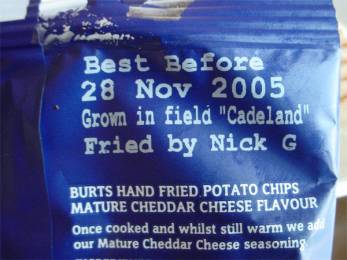
Food & drink
Vitamin enhancing fridges
We've said it before and we'll probably say it again, there is no such thing as a mature market, just mature marketers. Here's a good example. Over in Japan the refrigerator market is a mature market that declined by 9% last year. So how do you get people (almost all of whom have got a perfectly good fridge) to buy a new one? One thing you can do is tap into people's need states - in this case the need of people who are working harder and longer to eat healthily (or at least allow people the illusion that they're eating healthily). Another thing you can do is re-frame the purpose of fridges from something that keeps food fresh to something that enhances vitamin levels. Enter the Mitsubishi Electric Corporation's snappily named Umasa Vitamin Zoryo Hikari Power Yasai Shitsu fridge - the first fridge in the world that increases the vitamin C content of food through photosynthesis. Sales of the fridge have increased by 50% since it was launched last year. And if you think that's nuts, how about clothing with added vitamin C? The Fuji Spinning Company is selling a range of vitamin-enhanced underwear using substances that are typically found in cosmetics like ceramide. And finally Fujitsu General Ltd has launched an air purifier that releases microscopic vitamin C particles into the air.
Ref: Nikkei Weekly (Japan) 25 July 2005. 'New products ride health craze',
www.nni.nikkei.co.jp
In search of real
The topic for this year's Oxford Food Symposium was 'authenticity" and anyone who thinks that academics and intellectuals are out of touch with reality might be surprised to hear that the topic received a record number of papers. As anyone who follows food trends will know, authenticity (or 'realness' as it is sometimes known) is a hot topic, which explains the growing interest in everything from regionality and seasonality to organic food and the food miles debate. However, as Nicola Fletcher writing in the FT points out, authenticity in food is a difficult and naturally evolving subject. For example, when does a dish or ingredient gain or loose its 'authentic' status? One problem is separating food from its cultural and geographical context (is a pizza really 'authentic' outside of Italy?). Another issue is that ultimately authenticity, like truth, is a relative concept that doesn't really exist.
Ref: Financial Times 13/14 August 2005, 'In search of the real meal deal', N.Fletcher. www.ft.com See also www.oxfordsymposium.org.uk
Boil-in-a-bag is back
Sous-Vide cookery (from the French meaning 'under vacuum') was invented in France in the mid-70s and gained widespread popularity in the mid-80s when the Roux brothers started to use the process. However, the idea died out soon afterwards due to fears of food poisoning. The process, which involves cooking food in plastic bags at low temperatures, is generally thought to be superior to other cooking techniques because the texture, flavour and nutritional qualities of the food are preserved. Once cooked in this way, food can be stored in fridges for months because the air is locked out. In the UK Gastropubs are starting to use the technique again because you don't need a trained chef in the kitchen and portion control is so easy. El Bulli restaurant in Spain (reputedly the best restaurant in the world) is also a fan of the idea, while over in Australia the process has been used at a retail level by stores like 246ate in Melbourne and the now defunct Margaret Fulton's Kitchen in Sydney. However, food in plastic bags still has something of an image problem, so it may never get really hot.
Ref: The Times (UK) 3 September 2005. The Next Big Thing: 'Sous-Vide' Cooking', D. Rowan. www.timesonline.co.uk
Do we have an appetite for innovation?
The future of food is full of contradictions and counter-trends. In the one corner we have the multi-national food companies and food scientists who are sourcing globally and producing an array of functional foods to pander to our need for speed and convenience. The latest examples include Norelift, a French jam that contains anti-wrinkle compounds (that's right, a jam that makes you look younger). Meanwhile, over in Japan, you can buy a packet of Bust-Up, a chewing gum containing phytoestrogen, which is supposed to expand the size of your breasts (we're not making this up!). The goal of these products is to solve specific health problems for individuals. Equally, consumers are moving from buying ingredients to a mindset where each week is a series of meal problems where what's needed are instant meal solutions. For adults aged under-45 this also means finding foods to control their body shape, whereas for people aged 45-plus it means finding solutions for body repair and increased longevity. Over in the other corner we have the fresh food producers and consumers who are searching for the soul of food and celebrating slowness. To these people how and where food is produced is of critical importance and there is already a battle waging to prevent the big food companies from stealing words like health, fresh and natural from under their noses.
Ref: The Australian (AUS) 3-4 September 2005, 'Future Fare' , H.O'Neill.
www.theaustralian.com.au See also Last chance to Eat, the Fate of Taste in a Fast Food World, by Gina Mallett.
Gastronomy or gimmickry?
Alongside Heston Blumental's Fat Duck restaurant in the UK, Moto restaurant in Chicago (US) is probably home to the world's most interesting chef. However, whether Homaro Cantu is a gastronomic genius or just a circus performer is a matter of opinion. Apart from the now infamous edible menus, other innovations include hot ice cream, semi-magnetised food served on metal plates, table top mini-ovens and steak cooked by laser which is rare on the outside and medium in the middle.
Ref: Wallpaper (UK) July/August 2005 'How do you like your steak zapped', K.Chung. www.wallpaper.com See also www.motorestaurant.com
